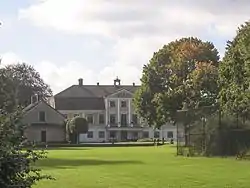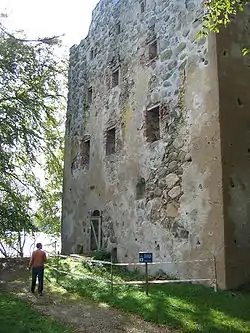Bergkvara, Växjö
Bergkvara is a manor house and ruined castle (slottsruin), located at the north beach of Bergkvarasjön ("the Bergkvara Lake") in Växjö, Sweden,[1] and described in Nordisk familjebok as "one of Sweden's oldest mansions in Värend, Bergunda and Öjaby parishes, Kinnevalds district and Kronoberg County, 6 km. west of Växjö".[2]



History
Bergkvara, a former "ornamental landscape", was bought by the Trolle family in the 15th century and rebuilt as a stone castle in the 1470s by Arvid Trolle. The castle was originally surrounded by two moats, serving as a system of defense. In the late 17th century, the inner moat had been partly filled and served as a fishpond while the outer moat served more as a ditch marking the limit of the castle bailey. By this time the residence had moved to the outer moat, as the tower house had lost its original function.[3]
In 1542, the castle was ransacked, plundered and set on fire after a long siege during the Dacke War (Dackefejden) by the peasant revolt of Nils Dacke, and became ruined in the 18th century.[3][4][5] In late 18th century, a new main building was under construction and finished in 1794.
References
- "Bergkvara Slottsruin". GuidebookSweden. Retrieved September 1, 2020.
- Various (1904). Nordisk familjebok (in Swedish). Retrieved July 29, 2014.
- Hansson, Martin (2006). Aristocratic Landscape. The Spatial Ideology of the Medieval Aristocracy. Lund Studies in Historical Archaeology. Lund University. p. 224. ISBN 91-22-02154-X. ISSN 1653-1183. Retrieved July 29, 2014.
- "Arvid Birgersson Trolle". Nordisk familjebok. Retrieved September 1, 2020.
- "Dackefejden kunde fällt Gustav Vasa". varldenshistoria.se. Retrieved September 1, 2020.